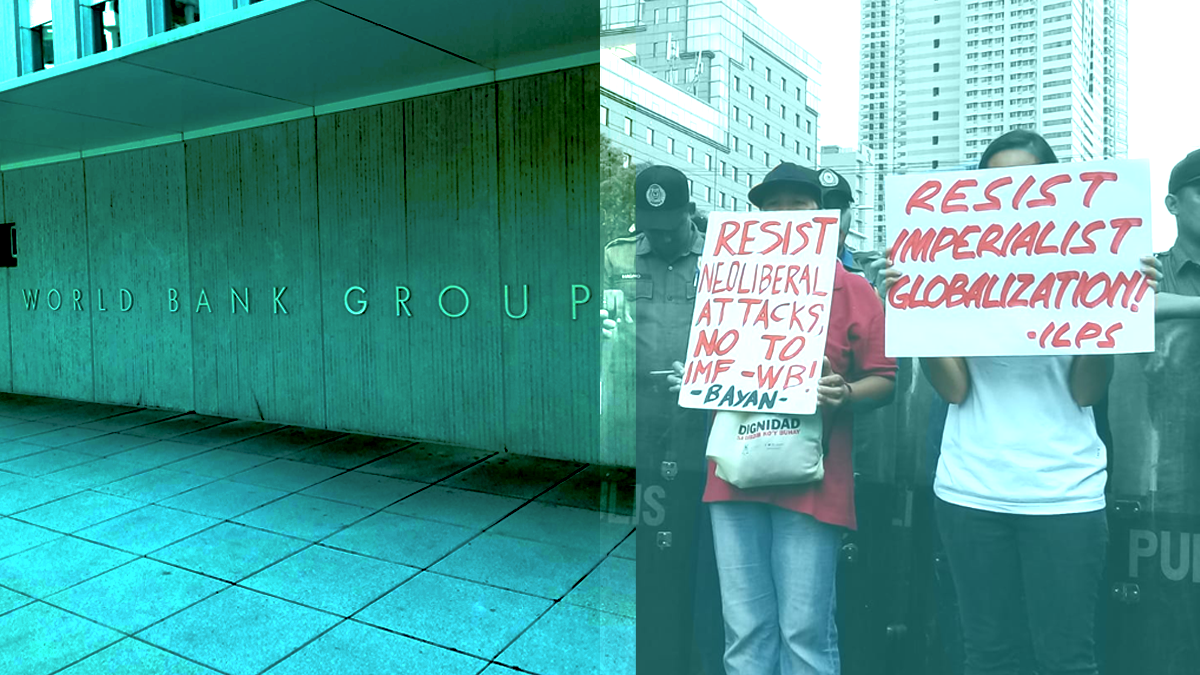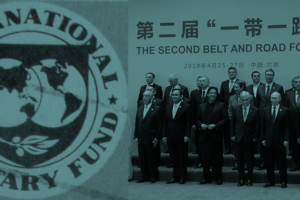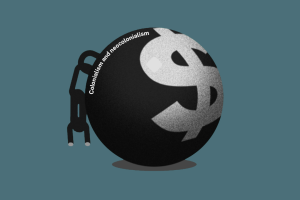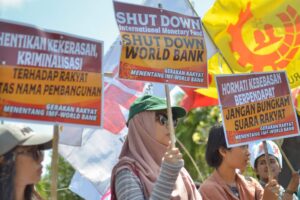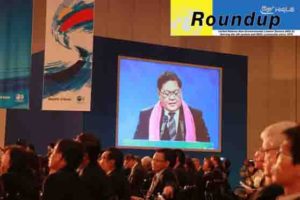Photos: The World Bank Group building / A protest in Manila, October 2018.
The World Bank Group (WBG) is one of the largest multilateral development banks in the world. Its professed mission: to end poverty and promote shared prosperity in developing countries.
But social movements and civil society, especially in the global South, have questioned the WBG’s economic role for decades. They have been criticising the United States’ (US) domination of the institution. The WBG has been opposed for sinking countries in debt, for imposing conditions on said loans, for shaping economies to the benefit of big business instead of people, and even for backing military dictatorships. Seventy-nine years since its establishment, a reckoning is necessary on the WBG’s performance as a supposed development bank.
In December 2022, almost 75 years after its first loan to a Southern country, the WBG released the Evolution Roadmap in a bid to reform itself. It runs parallel to another effort on reforming development banks, the Bridgetown Initiative, which seeks debt relief as well as increased WBG and investor funding for climate.
Like Bridgetown, the WBG Evolution Roadmap claims to adapt the institution with the world’s multiple crises. A status report of the Roadmap process will be expected in the Spring Meetings in April 2023.
2023: Roadmap to where?
The WBG Evolution Roadmap claims to evolve, through launching a process of mostly internal talks, three components: the WBG mission or their goals; the operational model or how they work; and their financing model or how they use the money from their country members.
The WBG mission claims to evolve towards a wider definition of poverty and prosperity. It promises to reduce the number of people living below USD 6.85, compared to a previous focus on a lower poverty line of USD 2.15.[1] With the higher poverty line, the WBG claims to address wider poverty. Another adjustment in the WBG mission is about responding to current global challenges, such as the climate crisis, pandemic preparedness, and even fragilities amid conflicts. All these adjustments are in a context of prior criticisms about the WBG’s use of a low poverty line, and unresponsiveness to the urgency of climate issues.
At face value, the adjusted WBG mission seems to be more inclusive and responsive to ongoing crises. Why should people be concerned about the WBG’s claims about making itself better?
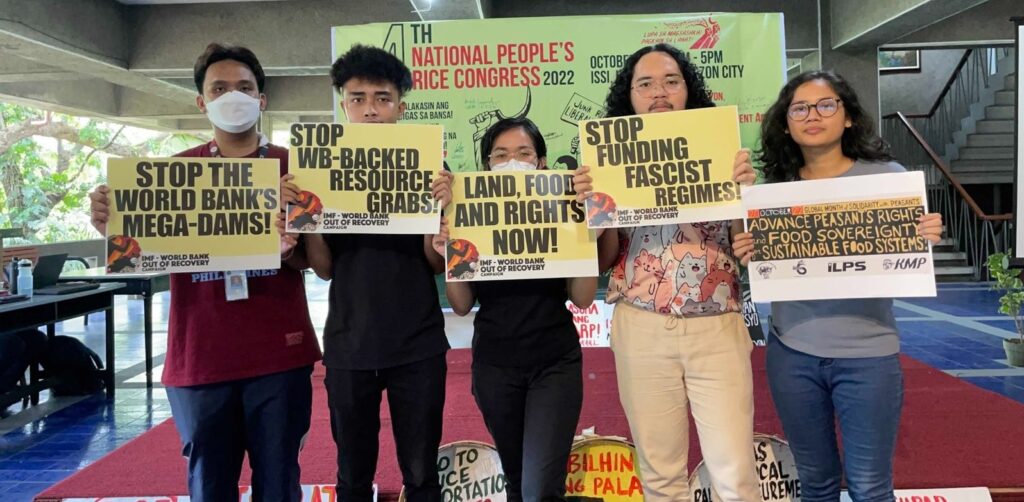
Photo: Peasant advocates raise their demands in a Manila forum / October 2022
No evolution as the private capital dogma stays
Under the Roadmap, the WBG claims to expand its long-standing mission. The WBG claims it wants to end poverty for more people and be more responsive to global crises. However, it retains economic dogma that has played a part in the current crises faced by peoples in the global South.
An already predominant notion retained in the Roadmap is the reliance on private capital and finance as solutions. The Roadmap advocates for more private capital mobilisation, such as co-financing and ways to reduce risks for investors, and what it calls private capital enabling, such as better business climates. It embeds the WBG’s Cascade approach, long criticised for prioritising private capital in responding to development problems while putting public investment as a last resort.
Inasmuch as the public sector is mentioned, it is secondary to the hype ascribed to capital: “While the public sector has an important role to play in global challenges like climate change, the private sector brings both the finance and technological innovations that could be game changers to tilt the balance towards a sustainable planet” [emphasis added]. The Roadmap also continued to endorse blended finance, criticised for using public money such as aid to attract profit-seeking investors.
The WBG keeps relying on a discredited framework despite clear harms and unclear benefits. With the recent history of crises, such dogmatic inertia is dangerous. Big, unregulated private finance was a driver of the 2008 crisis that triggered a global recession. Private creditors who flocked to Southern markets after 2008 are also responsible for the debt burdening countries today, with peoples in the global South footing the bill via budget cuts, privatisations, and new taxes. Financial markets continue to be volatile; just three months into 2023, fears of a global banking crisis loom after the collapse of some US banks.
Private capital, through big multinational companies, banks, and financial investors, are in the business of large-scale extraction of fossil fuels and natural resources. The largest financial companies have major interests in fossil fuel businesses. The global South has lost trillions of wealth and resources in a history of low wages and cheap exports – far from the WBG’s push to tap private capital to turn the “billions to trillions” of development financing.
The professed WBG mission and the retention of old tenets are thus antagonistic. This could be interpreted in at least two ways. One way is to view WBG’s private capital dogma as incoherent with its newly expanded mission. A second is to look at the WBG’s nominally agreeable mission as a justification to sustain the dominance of private capital. The goal is used to give new lease to old systems.
If the WBG keeps the same thinking it has championed for decades – is there really evolution even on its own terms?
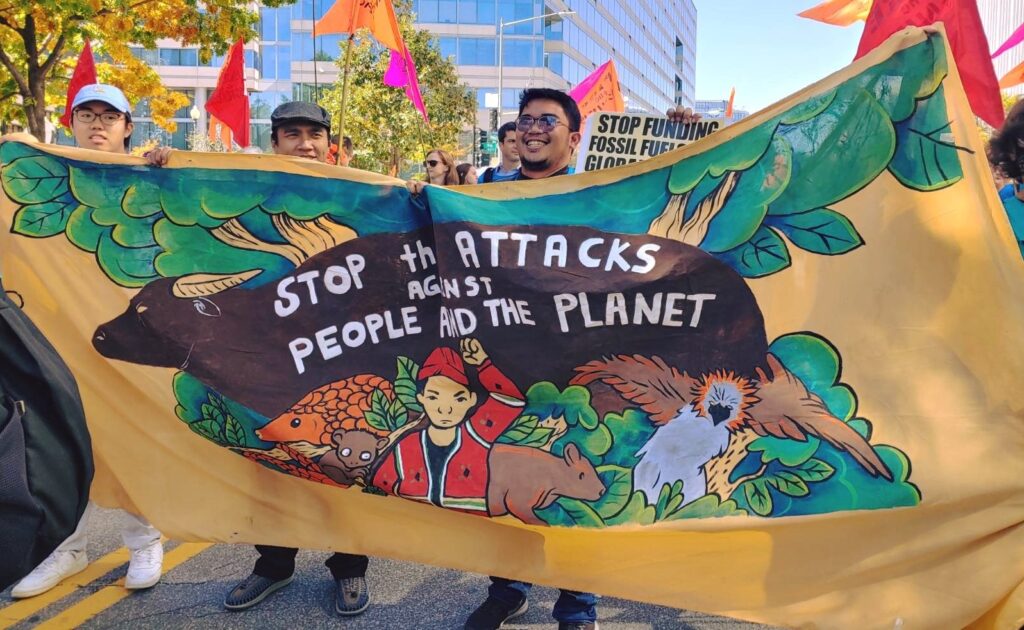
Photo: Activists during a march in Washington, DC / October 2022
WBG reform proceeds from a silent denial of WBG harms
The WBG Roadmap is an answer. But how is the problem posed? The Roadmap is responding to the problem of the WBG’s being out of sync with climate and sustainability needs. The WBG has to quickly adapt to ongoing crises, adjusting its operations and financing to new realities.
This haste to move forward should warrant more reflection. The WBG Roadmap is concerned about the “crisis of development,” of poverty, debt burdens, inflation, climate change, hunger, conflict, and displacement.
But striking is the silence of the Roadmap about the WBG’s active role in this dire situation. Despite appealing to climate action, the WBG has continued its financing of fossil fuels, and other projects that take away communities’ resources. The Roadmap also neglects the harmful effects of rising debts on public healthcare and social protection, despite the WBG’s claim to support pandemic preparedness. The WBG has refused to cancel debt burdens despite the pandemic, as countries spend more on repaying debts than on health.
Southern social movements have long rejected the WBG and the International Monetary Fund’s (IMF) conditionalities. WBG policy influence has forced privatisations, cuts on social service budgets, and public-private partnerships that skewed benefits to business, all of which left people unprotected from the pandemic and rising cost of living. WBG-backed projects were criticised for resource grabs and the displacement of peasant and Indigenous communities, especially harming rural women.
The Roadmap seems to be leading attention away from these realities and other historical elephants in the room. In history, the neoliberal focus emerged during a time of rising Third World governments and national liberation movements, many of which pursued economic development models that may have been unaligned with the US-promoted model. In contrast, the model advocated by the WBG integrated Southern countries in the world economy as sources of cheapened resources and labour, undermining unionised labour and hard-won rights along the way.
In pushing a reform without accounting for harms, the WBG is selling an ointment for a wound it itself inflicted, and silently denies inflicting.
Beyond silent denial the WBG Roadmap boasts of the institution’s political influence across countries, in an affront to economic sovereignty:
“The WBG has direct access to government policy- and decision-makers in advanced and developing economies, who can affect the policy and market reforms as well as the project framing and preparation work essential to mobilizing the massive pools of private capital that are key to the success of this [WBG] mission” [emphasis added].
For social movements and civil society today, addressing public needs is a key problem. The question is whether the track record of the WBG is fit for this purpose. Should WBG economic influence be more entrenched in a time of crises, or should its track record merit reducing or rejecting its influence? Is it a time for more ointments, or an end to the infliction of wounds?
US geopolitical interests loom over WBG reform
As a US-dominated institution, the WBG’s history is linked with the superpower’s economic and foreign policy priorities. For instance, the WBG promoted a US-aligned economic model during the Cold War. Today, the legitimacy of a US-led institution is important for the declining superpower, given its competition with China and Russia.
The year 2023 might prove to be another moment of adaptation amid geopolitical stakes. Impetus for the Roadmap came from the G20’s push for reforms to increase WBG lending, as well as the US’ push for the WBG to reassert its role amid current crises. The US Treasury Secretary, who represents the superpower in WBG governance, has previously called on the IMF and the WBG to modernise. In April 2022, two months into the Ukraine war and its effects, Yellen called for a “new Bretton Woods” to revitalise the key role of these institutions, in a reference to the 1944 Bretton Woods Conference that created the IMF and the would-be WBG.
This effort was arguably harmed when outgoing WB President David Malpass attracted controversy, in the last quarter of 2022, for his evasive comments on climate science. None other than the White House has condemned Malpass. Months later, the US let go of Malpass. The US put forward its new nominee for WB President less than a week later. The nominee, Ajay Banga, came from Mastercard, Citigroup, and the International Chamber of Commerce, and was involved in initiatives that put a “climate-aligned” paint to the machine of capital.
Banga will likely be selected by the WBG as its next President, with the US laying claim once again to the leading role in the world’s largest development bank. Meanwhile, Russia is exploring prospects to challenge the US nominee, amid the halting of WBG programmes in Russia due to the Ukraine war. As to China, the US and its allies have so far succeeded in limiting the rising superpower’s voting shares in the Bank, only conceding minor increases from the last 13 years. Across the ocean from the WBG headquarters in Washington, DC, the US and China are also competing for economic influence: the US is promoting an Indo-Pacific Economic Framework (IPEF), a counter-point to the China-led trade deal, the Regional Comprehensive Economic Partnership (RCEP).
With US power still dominant in the WBG, further push of its economic influence, and with it the subsumed position of the global South in the world economy, could be expected.
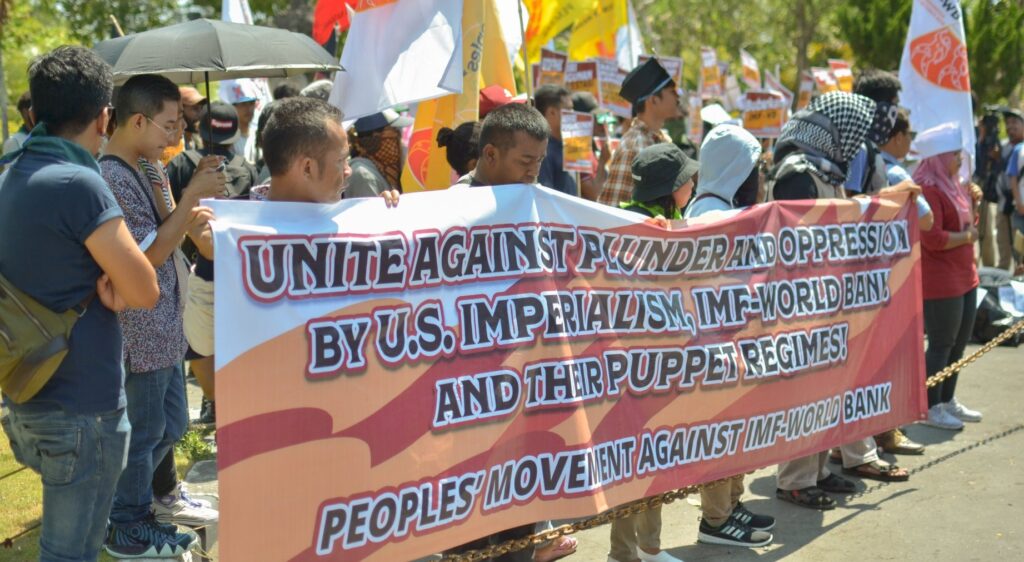
Photo: Protest during the People’s Global Conference against the IMF-World Bank in Bali / October 2018
Reform, or reckoning?
The WBG’s history is a tale of adapting its operations in the course of the past century’s crises and geopolitics—from the Cold War; to neoliberalism after the 1970s oil crisis and amid a debt crisis and the rise of a Third World bloc; and the sustainable development agenda within the decade after the 2008 crisis.
The current WBG reform could be viewed as another adaptation, amid multiple crises, obscene inequalities, and after some years of social unrest. It is an effort to entrench relevance and a continued role in an emerging world where the US is not the sole superpower.
Our time requires major changes in systems proven unfit for the purpose of enabling people to shape their own paths—economically and politically.
Seventy-nine years into the WBG’s history is a good moment to assess its record as a supposed development bank. If policies, projects, and operations—of an institution claiming to change—is not addressing the roots of current harms on economic and social rights, what role should it continue to play in the global South, if at all? Are there not more democratic avenues to pursue economic and development policymaking? How do we account for the WBG’s record of policy influence that shaped our current world of multiple crises? For social movements, their long-standing demands on curtailing the WBG’s power in the global South are timelier than ever.
